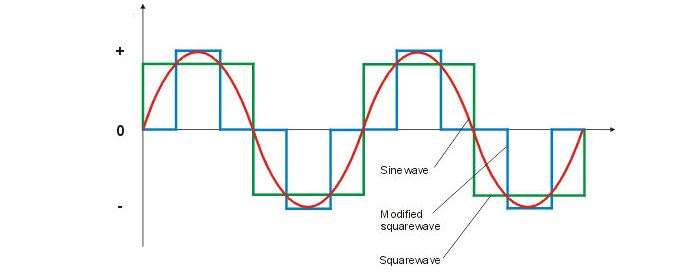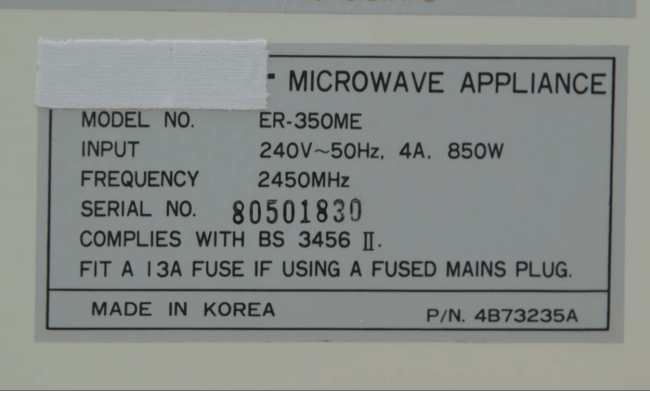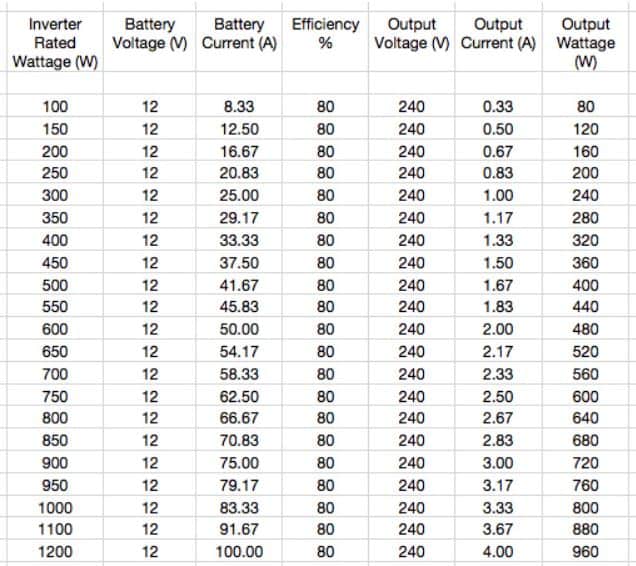
At Horton Common, our guests have access to fully serviced pitches with a 16A electrical supply. However, when talking with our guests, we often discuss other sites they have visited, and from time to time, we discuss ‘wild camping’. Another way to describe wild camping is going ‘off-grid‘. This may be at a dedicated caravan site with no mains power, or it could be a day at the beach. In either case, even without a mains power supply, you may want access to a 230V power supply to run various appliances. This is possible by using a 230V inverter in combination with your 12V leisure battery. However, inverters are based on different types of technology, for instance, sine wave vs modified sine wave inverters.

Before you choose an inverter for your caravan or motorhome there are lots of questions you need to ask yourself – Image: Amazon.co.uk
Disclaimer: Hey! By the way… any links on this page that lead to products on Amazon or Caravan Guard are affiliate links, and I earn a commission if you make a purchase, with no additional cost to you 🙂
- Dissolves waste and removes odours naturally and has delightful mild fragrance
This post is meant to be a pretty comprehensive guide on inverters for a caravan or motorhome, so naturally, its pretty long.
You can use the Table of Contents below to skip to a particular section if you’re in a rush and don’t have time to read all my musings. 🙂
Want To Visit Horton Common? – Book Here
Table of Contents
Sine Wave vs Modified Sine Wave Inverters?
When it comes to purchasing an inverter for your caravan or motorhome, you will have an important decision to make.
Are you going to go with a modified sine wave inverter (generally cheaper)? Or are you going to purchase a true/pure sine wave inverter?
Its a very important decision to make as it influences the type of appliance you can run from the inverter. So we better discuss what the differences between the two are.
The leisure battery in your caravan or motorhome produces direct current (DC), and your home is supplied with alternating current (AC).
On a graph, DC is drawn as a straight line of current where AC has peaks and troughs. If you have the time, the video below does a good job of explaining the difference between DC and AC power.
Interestingly, Thomas Edison tried to establish a DC power network across the US at the turn of the 20th century.
However, to transmit power over long distances, AC is more efficient and can use much thinner wires. Hence, George Westinghouse, with the AC system, eventually won the ‘Current War’.
Helped by the design of the AC motor developed by Nikola Tesla. You’ll obviously be familiar with Tesla if you’re interested in electric tow cars.
Anyway, back to the topic at hand. The inverter’s job is to take that 12V DC from your leisure battery and turn it into 240V AC.
If you want to know the detail on how inverters do that, I encourage you to read Simon’s post, over at Caravan Chronicles.
Simon also provides an illustration of the difference between Sine Wave AC and Modified Sine Wave AC (referred to below as squarewave).

Opinion – Avoid Modified Sine Wave Inverters For Your Caravan/Motorhome
So as you can see from the graph above, a modified sine way is a rough imitation of a true AC sine wave which your home appliances are used to.
Therefore, as a result, some of your home appliances may not take kindly to being plugged into a modified sine wave inverter.
An appliance which may struggle by either not working correctly or not at all includes anything typically with a microprocessor.
Which today includes most appliances. You may be able to use a modified sine wave inverter for simple battery chargers, but that’s about it.

I would recommend against purchasing a modified sine wave inverter for your caravan or motorhome – Image: Amazon.co.uk
If modified sine wave inverters are so limited in their application, why are they still available? Well, quite simply, they are cheaper to produce.
And in the past, fewer appliances had computer chips in them, so their use was more applicable. However, today, I would recommend avoiding modified sine wave inverters.
Purchasing one will severely limit which appliances you could run from your caravan’s leisure battery.
Inverter Efficiency
For an inverter to take 12V DC and turn it into 230V AC power, its going to use some power to complete that task. How much power depends on the individual inverter.
Some may have a peak efficiency of just 50-60%, whereas others are going to be between 80-90% efficient.
If you do not see an efficiency rating in the product spec sheet, don’t presume its 100% efficient. That is simply not possible based on the laws of physics.
So if the efficiency rating is not stated, on average, its going to be around 80%. Now, if you noted in the previous paragraph, I stated ‘peak’ efficiency, that’s an important distinction.
An inverter which has a peak efficiency of 90% at its maximum power output may only have an efficiency of 50% at half its maximum power output.
This can make it tricky when it comes to choosing the best size of inverter to buy.
What Size Of Inverter Do You Need?
So we now know to avoid modified sine wave AC inverters and to focus on true, also known as pure sine wave inverters. The next question becomes, what size do I need?
There is a range of appliances in your caravan you may want to use.
They could include a caravan kettle, microwave, toaster, or simply keeping your laptop powered up. Let’s use the microwave as an example.
Microwave Example
You need to be very careful sizing an inverter for a microwave in a caravan or motorhome. The appliance may have an output power rating of say 500W, but the input power may be 850W.
So when it comes to purchasing an inverter to suit, ignore the output power of the microwave and just focus on its input power requirements.

So if we want to run an 850W microwave, we want an 850W inverter right? Remember, we need to factor in the efficiency losses.
If we presume the inverters on offer are 80% efficient, we need to cover that 20% energy loss. Therefore, our requirement is 850W + 20% more.
That would mean a 1,020W inverter is required as a minimum. For this particular example, at least a 1,100W inverter would be required.
Caravan Inverter Power Chart
Simon over at Caravan Chronicles, in a separate post, produced a handy chart to illustrate the relationship between the rating of an inverter and its actual output wattage.
What it also shows is the amount of battery current required. As you will note below, for our 1,100W inverter in the example above, the battery amp draw is 91.67A (amps)!
That’s a lot of power when you consider a typical leisure battery is around 100A.

So if we have a 100A leisure battery, it would appear we could power the inverter, pulling 91.67A for close to an hour.
Unfortunately, this is not the case, as a typical lead-acid leisure battery should not be discharged below 50%. Going below a 50% discharge may damage the leisure battery.
However, some leisure battery chargers can recover battery damage.
In summary, a 100A leisure battery would, in reality, only be able to provide a cumulative microwave operating time of 30min.
That’s also presuming no other power is pulled from the battery, which is obviously not likely.
Getting Power Back Into The Leisure Battery
As can be seen above, while you can run a microwave in a caravan or motorhome with an inverter, it pulls a lot of power from the leisure battery.
If you are away for just a couple of days, this might not be a problem. However, if you had a caravan motor mover fitted, there would likely not be enough power left to use it.
If you’re away for more than a couple of days with a high-power inverter and lots of appliances, you need a source of power.
Obviously, mains power is not available, hence why you’re running the inverter. Therefore, having either a portable or fixed caravan solar panel setup needs to be a serious consideration.
Inverter Options For Your Caravan Or Motorhome
So below, I’ve researched a couple of 230V inverter options you could consider for your caravan or motorhome. Please note the discussion above to choose the size of the inverter you require.
Also, in reference to my comments above, I’m only referencing pure sine wave inverters and no modified sine wave inverters.
BESTEK 300W Inverter
Might as well start off small. This BESTEK inverter will plug into the 12V socket within your caravan or car, no need to connect it directly to the leisure battery with clips.
It has a rated power of 300W, with a peak of 700W. As can be seen from the promotional image below.
This small inverter could be suitable to power TV’s, laptops, tablets and phone chargers. As this inverter has some USB power sockets you could potentially power a TV/laptop while charging your phone.

This small and compact 300W inverter could be suitable for most of your caravan entertainment devices – Image: Amazon.co.uk
The BESTEK 300W inverter does feature an inline fuse and low voltage protection. However, the product description does still advise turning off the inverter when not in use.
It’s also worth noting the shutdown voltage is around 10.5V. At this point, the leisure battery will already be below 50% discharge.
Therefore, its best you keep an eye on the voltage of the leisure battery yourself.
BESTEK 300W Inverter Features
- 1 AC Outlet, Dual USB Port
- 300W Rated, 360W Max, 700W Peak
- Shutdown: DC 10V-11V
NovoPal 1000W Inverter
If you want to power more than just entertain devices in your caravan or motorhome and you’re looking for more power, the next step up is something like this 1000W NovoPal Inverter.
You cannot connect this inverter through the 12V socket in the caravan, it needs a direct-to-battery connection. If you tried to use the 12V socket within the van, it would melt the fuse.

This 1000W inverter would be suitable for more power-hungry devices in your caravan or motorhome – Image: Amazon.co.uk
The NovoPal 1000W inverter kit comes with the wires required for the direct battery connection. It could be located permanently within the living space of your caravan or motorhome.
However, its important you provide sufficient ventilation of the unit.
A useful remote control panel with an on/off button is provided. The remote panel also provides the health status of the leisure battery.
As this is a more powerful device than the 300W inverter above, you are provided with two 3-pin plug sockets.
NovoPal 1000W Inverter Features
- 2 AC Outlets, USB Port
- 1000W Rated, 2000W Peak (1 second)
- Efficiency: 90≥% (12V DC)
EDECOA 3000W Inverter
I know, its a bit of a jump from a 1000W inverter to a 3000W inverter. However, many of the inverters on Amazon between 1000W-3000W have similar features.
I wanted to show this 3000W inverter to illustrate its physical size, its massive! Its 35cm long and weighs 4.3kg.

Very few if any caravans or motorhomes could (or should) consider running a 3000W inverter from a leisure battery, but they are available – Amazon.co.uk
If you did ever want to consider running an inverter as large as this first, you’ll need a pretty massive leisure battery to last more than a few minutes.
Second, the diameter of the positive/negative wires connecting to the battery needs to be of sufficient diameter.
And for a 3000W inverter such as this, we are talking finger width. Also, an inline fuse is a must.
Furthermore, when it comes to a large inverter such as this which would require at least two leisure batteries, you need to be aware of the impact on the weight of your caravan.
EDECOA 3000W Inverter Features
- 2 AC Outlets
- 3000W Rated, 6000W Peak (less than 1 second)
- Efficiency: 85% (12V DC)
Conclusions On Inverters For Caravans & Motorhomes
If you want to go wild camping off-grid, there are some appliances and home comforts you may want to take and need a 230V supply for.
Therefore an inverter can be a useful piece of kit to provide you with the flexibility to power a range of devices from your caravans or motorhome’s leisure battery.
However, first, you need to make sure your leisure battery is up to the challenge. Is your leisure battery big enough to last more than a few minutes with your chosen 230V appliance in use?
If so, you then need to purchase an inverter that can provide enough power (continuously) to cope with the demands of the appliance.
No inverter is 100% efficient, and you need to factor that into your decision.
Finally, In my opinion, no matter what battery protection features the inverter claims to have, carefully monitor your leisure battery.
When the inverter is in use, keep an eye on the voltage reading of the battery. If the battery is at 12.4V or below, you are at or below a 50% discharge.
Therefore, at this point, with a standard lead-acid leisure battery, you should stop using the inverter. Also, always turn off the inverter when not in use.
Even with no appliances pulling a load, it may still consume power and leave you with a flat battery.
I hope you found this post on 230V inverters for caravans and motorhomes useful. I also hope you consider coming to visit us at Horton Common at some point in the future. 🙂
FAQ
Previously before 2003, the UK mains voltage power supply was 240V at 50Hz. Its now 230V at 50Hz. The objective was to bring the UK supply closer in line to the EU which is at 220V. An inverter branded as 240V or 230V should be suitable for UK appliances.
Yes, many of them can be. Typically the inverter will have a fan that will generate some noise. How much noise the fan on the inverter generates will depend on the size of the fan and its quality (good/bad quality bearings). Essentially, don’t expect any inverter to be used in your caravan or motorhome to be silent.
Therefore you’re going to want to turn it off overnight. Tuning inverters off when not in use is a good idea anyway, as some inverters will drain your battery even when no 230V appliance is in use.
First, you need to evaluate what is the highest power rated appliance you want to run, this could typically be a hairdryer or it may be a microwave. You need to make sure the inverter can cope with the peak power requirements of that appliance while factoring in efficiency losses.
Some inverters come with a couple of 230V 3 pins sockets, but you’re not going to be able to run a hairdryer and a microwave at the same time without a pretty huge inverter and multiple leisure batteries. But the answer to this question is generally yes. Its generally better to buy an oversized inverter if you can afford it to cover the use of a variety of devices.
Want To Visit Horton Common? – Book Here


